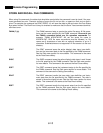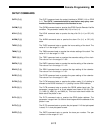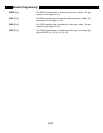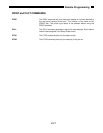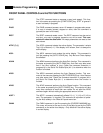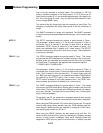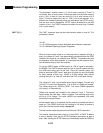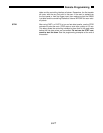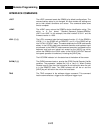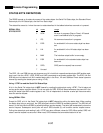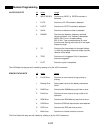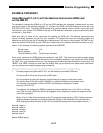
6-26
Remote Programming
The parameter i selects a trace (1, 2, 3 or 4) and is required. If Trace i is
not stored, then an error occurs. Points are read from the buffer starting
at bin j (j≥0). A total of k bins are read (k≥1) for a total transfer of k*4
bytes. To read a single point, set k=1. Both j and k are required. If j+k
exceeds the number of stored points (as returned by the SPTS? query),
then an error occurs. Remember, SPTS? returns N where N is the total
number of bins - the TRCB? command numbers the bins from 0 (oldest)
to N-1 (most recent).
FAST (?) {i} The FAST command sets the fast data transfer mode on and off. The
parameter i selects:
i=0: Off
i=1: On (DOS programs or other dedicated data collection computers)
i=2: On (Windows Operating System Programs)
When the fast transfer mode is on, whenever data is sampled (during a
scan), the values of X and Y are automatically transmitted over the GPIB
interface (this mode is not available over RS232). The sample rate sets
the frequency of the data transfers. It is important that the receiving inter-
face be able to keep up with the transfers.
To use the FAST2 mode, a ROM version of 1.08 or higher is required in
the SR850. The FAST2 version uses the lock-in transmit queue to buffer
the GPIB data being sent to the host. Since the transmit queue can
buffer a maximum of 63 X and Y data pairs, the host can only be diverted
for short periods of time (e.g. 120mS at 512Hz sample rate) without
causing the lock-in to "time out" and abort the FAST mode data transfer.
The values of X and Y are transferred as signed integers, 2 bytes long
(16 bits). X is sent first followed by Y for a total of 4 bytes per sample.
The values range from -32768 to 32767. The value ±30000 represents
±full scale (i.e. the sensitivity).
Offsets and expands are included in the values of X and Y. The trans-
ferred values are (raw data - offset) x expand. The resulting value must
still be a 16 bit integer. The value ±30000 now represents ±full scale
divided by the expand factor.
At fast sample rates, it is important that the receiving interface be able to
keep up. If the SR850 finds that the interface is not ready to receive a
point, then the fast transfer mode is turned off.
The fast transfer mode may be turned off with the FAST0 command.
The transfer mode should be turned on (using FAST1 or FAST 2) before
a scan is started. Then use the STRD command (see below) to start a
scan. After sending the STRD command, immediately make the SR850 a



